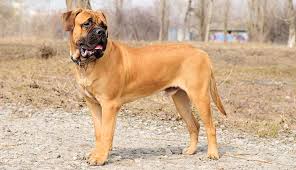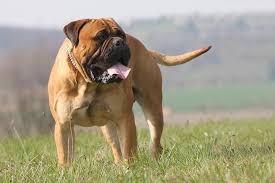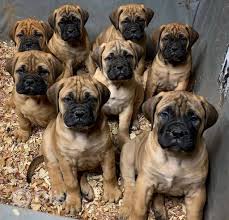The Bullmastiff is a large, powerful dog breed that originated in England in the mid-19th century. Developed from the Mastiff and the Bulldog, the Bullmastiff was originally bred to protect gamekeepers from poachers. Today, they are known for their loyalty, courage, and calm demeanor, making them excellent family pets and guard dogs.
The Bullmastiff is a muscular and robust breed, with males standing at a height of 25 to 27 inches and females standing at a height of 24 to 26 inches. They weigh between 100 to 130 pounds, with males being slightly larger than females. Their coat is short, dense, and comes in shades of fawn, brindle, or red. Their face is characterized by a short muzzle, wrinkled forehead, and drooping jowls.
One of the Bullmastiff’s most notable traits is their protective nature. They are highly attuned to their family and are quick to sense any potential danger. With proper training and socialization, they can be excellent guard dogs. However, their protective instinct does not make them aggressive. In fact, they are known for their calm and gentle demeanor, making them great with children and other animals.
Despite their large size, Bullmastiffs are not particularly active dogs. They prefer to lounge around the house and are content with short walks and playtime in the yard. However, they do require regular exercise to maintain their physical and mental health.
Training and socialization are important for the Bullmastiff breed. They respond well to positive reinforcement training methods and require consistent, firm, and gentle guidance from their owner. Early socialization is also crucial to ensure they are comfortable around strangers and other animals.
In addition, the Bullmastiff is a remarkable breed that combines strength, loyalty, and a gentle disposition. They make excellent family pets and guard dogs, and with proper training and socialization, they can be a valuable addition to any household.
The Bullmastiff is a large and muscular dog breed, with a powerful and imposing appearance. They have a broad head, a short muzzle, and drooping jowls that give them a distinctive look. Their coat is short and dense, and it comes in shades of fawn, brindle, or red. Overall, the Bullmastiff’s physical appearance is both strong and impressive.
Temperament-wise, the Bullmastiff is known for its loyalty and courage. They are highly protective of their family and can be wary of strangers. However, they are not aggressive or confrontational, and they do not bark excessively. They have a calm and gentle demeanor, making them great with children and other animals. With proper socialization, they can be very friendly and affectionate.
The Bullmastiff’s personality is often described as loving, loyal, and obedient. They are devoted to their owners and enjoy spending time with them. They are also very intelligent and responsive to training, which makes them easy to train. However, they can be stubborn at times, so it’s important to establish clear boundaries and provide consistent training.
However, the Bullmastiff is a breed with a strong personality and a gentle nature. They are loyal and protective, making them great guard dogs and family pets. They require regular exercise, socialization, and training to thrive, but with proper care, they can be a wonderful addition to any household.
Read Also: Millet and Sorghum Harvesting and Threshing
History and Origin of the Bullmastiff Dog Breed

To address these issues, gamekeepers began crossbreeding Mastiffs with Bulldogs. Bulldogs were smaller and faster than Mastiffs, and they were more manageable. The result was the Bullmastiff, a breed that combined the size and strength of the Mastiff with the agility and tenacity of the Bulldog.
The Bullmastiff was first recognized as a breed in 1924 by the English Kennel Club. By that time, the need for gamekeepers had declined, and the breed’s role had shifted to that of a guard dog. During World War II, Bullmastiffs were used to guard military installations and help locate wounded soldiers on the battlefield.
The Bullmastiff made its way to the United States in the early 20th century, and it was recognized by the American Kennel Club in 1934. The breed’s popularity grew steadily throughout the 20th century, and today, it is a beloved companion and guard dog around the world.
The Bullmastiff’s unique history and origin have shaped its temperament and physical characteristics. The breed’s protective nature can be traced back to its origins as a guard dog, while its muscular build and distinctive appearance are a result of its Mastiff and Bulldog ancestry. Today, the Bullmastiff remains a breed with a rich history and a strong sense of loyalty and duty.
Health Issues and Lifespan Of Bullmastiff Dogs

To ensure the best possible health for your Bullmastiff, it’s important to choose a reputable breeder who performs health screenings on their dogs. Regular veterinary check-ups and a healthy diet and exercise regimen can also help keep your Bullmastiff in good health.
The Bullmastiff has a relatively short lifespan compared to some other breeds, typically living between 8 and 10 years. However, with proper care and attention, some Bullmastiffs may live longer. Owners can help ensure a long and healthy life for their Bullmastiff by providing regular exercise, a nutritious diet, and plenty of affection and attention. Regular vet check-ups and prompt treatment of any health issues can also help prolong your Bullmastiff’s life.
Read Also: Nutritional Profile and Introduction to Food Rating System Chart of Cauliflower
Bullmastiff Dog Breed Complete Grooming and Care Guide

First and foremost, regular brushing is key to keeping your Bullmastiff’s coat healthy and shiny. A quick brush once a week should be sufficient to remove loose hair and prevent matting. You can also use a damp cloth or chamois to wipe down your Bullmastiff’s coat and remove any dirt or debris.
Bathing your Bullmastiff is also important, but it’s best not to do it too often. Bullmastiffs have sensitive skin and frequent bathing can dry out their coat and cause irritation. Aim to give your Bullmastiff a bath every two to three months, or as needed if they get particularly dirty or smelly.
When it comes to nail trimming, it’s best to leave it to the professionals. Bullmastiffs have thick, strong nails that can be difficult to trim properly without the proper tools and training. Take your Bullmastiff to a groomer or veterinarian for regular nail trimmings to prevent them from becoming too long and causing discomfort or injury.
In addition to grooming, there are a few other things to keep in mind when caring for your Bullmastiff. Regular exercise is important for their physical and mental well-being, so be sure to provide daily walks and playtime. Bullmastiffs also thrive on human companionship, so be sure to spend plenty of quality time with your furry friend.
Another important aspect of Bullmastiff care is proper nutrition. As a large breed, Bullmastiffs require a balanced diet that is high in protein and low in fat. Be sure to feed your Bullmastiff a high-quality dog food that meets their nutritional needs and provides them with the energy they need to stay healthy and active.
Finally, regular veterinary check-ups are essential to keeping your Bullmastiff healthy and happy. Be sure to take your Bullmastiff to the vet for regular check-ups and vaccinations, and to seek prompt treatment if you notice any changes in their behavior or health.
Overall, caring for a Bullmastiff can be a fun and rewarding experience. With regular grooming, proper nutrition, and plenty of love and attention, your Bullmastiff can live a happy and healthy life by your side. So, grab your brush and get ready to show your Bullmastiff some love and care.
Bullmastiff Puppies

Bullmastiff puppies are usually born in litters of 6 to 12 puppies, and they grow quickly. By the time they are 8 weeks old, Bullmastiff puppies are ready to go to their new homes. During the first few weeks of their lives, Bullmastiff puppies rely on their mother for nourishment and warmth. They begin to explore their surroundings and interact with their littermates as they grow older.
When you bring your Bullmastiff puppy home, it’s important to provide them with a safe, comfortable space to sleep and play. Puppies need plenty of toys to keep them occupied, as well as regular exercise and socialization to help them develop into well-adjusted adults. Positive reinforcement training is also important for Bullmastiff puppies, as they can be stubborn and independent at times.
As your Bullmastiff puppy grows, they will need regular veterinary check-ups and vaccinations to keep them healthy. It’s also important to provide them with a nutritious diet that meets their growing needs. Bullmastiff puppies can be prone to obesity, so it’s important to monitor their weight and adjust their diet as needed.
One thing to keep in mind when raising a Bullmastiff puppy is that they grow quickly and can be quite large. It’s important to provide them with plenty of space to move around and play, as well as plenty of exercise to help them develop strong muscles and bones.
Overall, Bullmastiff puppies are a joy to raise and can make wonderful companions for the right owner. With proper care, attention, and training, your Bullmastiff puppy can grow up to be a loyal and loving companion for years to come.
Read Also: Protection and Development of Water Resources Guide
